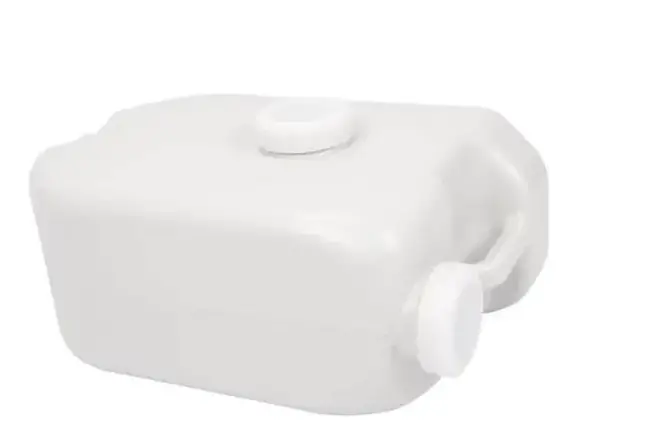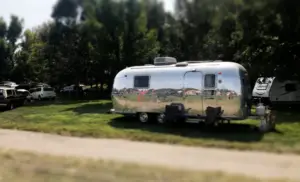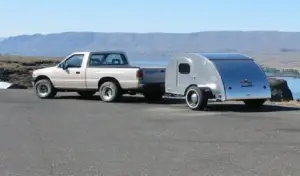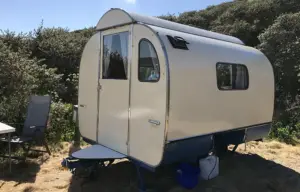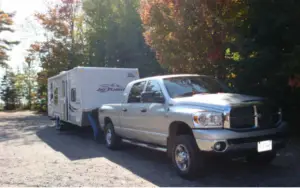RV owners need water when they travel. You will require water for cooking, drinking, and shower. Water is also a necessity when you need to clean up while traveling.
Filling up fresh water tank is a must for RVers cause that is where you will get the supply of potable water.
You must fill the tank before heading out, particularly when you don’t know where to get the next water supply. Although some RV owners can buy gallons of drinking water or perhaps bring some bottled water with them, this may be too expensive and inconvenient with the need to lug around the gallons and such.
A travel trailer can carry twenty to a hundred gallons of freshwater, while fifth wheels can hold anywhere between fifty-five to ninety-two gallons of freshwater.
Class A motorhome can store between seventy to a hundred gallons. where as Class B RV, on the other hand, can only hold between fifteen to forty gallons of freshwater. Class C RV can carry thirty to sixty gallons, camper vans can likewise hold between fifteen to forty gallons of freshwater.
Check water storage capacity for different RV models.
Depending on what RV you have, your water storage capacity will vary. Though capacity of most RV’s seem good it may not be sufficient for everyone. You may have to refill if the number of travelers are more or you are traveling long routes.
Ways to carry extra water in RV
Most RV owners carry portable water containers with them, as this makes it easy to refill their freshwater tank without the need to move the RV every time it is necessary to fill the freshwater tank.
You only need to bring the container to a water outlet and then refill the potable water.
The need for more water, especially when camping, is crucial, and you need to think of ways how you can bring extra clean water with you and ensure that you won’t dehydrate while outdoors.
Aqua tank water bladder
This water container can fold up and is compact when empty but it can hold an extensive amount of water when required. However, the downside is the extra weight it will add to the RV, and it is best for travel trailers or fifth-wheel RVs.
Collapsible water containers
Most RV owners prefer this since it can fold flat and is easy to store when empty. It can hold up to five gallons of water and beneficial when you need more water supply.
Jerry cans
It can hold up to seven gallons of water and most commonly used by RVers. The container is also durable and is mountable outside the vehicle. It will make it less of a bother if placed outside rather than inside the RV cause it takes up space compared to the collapsible water containers.
You can place such portable water storage on top of RVs, tow vehicles, in car trunks, or back of SUV. The weight is another issue, and you are only advised some of the portable water storage to be used on heavy rigs and not on lightweight vehicles.
Can you add a second freshwater tank to the RV
It is unfortunate when you are out camping with your family, and water suddenly runs out, and you are just on your first day of camping.
To avoid out of water circumstances, RVers can go with additional portable water storage or freshwater tank. It is done by linking two tanks together with the same level and height, so a single freshwater tubing is used to fill both.
There should be a water line connected at the bottom of both tanks while a vent line is fixed at the top of the tanks to connect them.
Both tanks must be leveled so that both will drain simultaneously, and filling them will be easy. The new tank must have its specific fittings and drain valve of its own.
If you add a freshwater tank, you can get a three-gallon RV water tank for less than $50, and if you are planning to have your RV fitted with a hundred-gallon water tank, you have to be ready to spend $550 and above.
The price will rise as the quantity of the water tank increases. The most expensive water tank will be a tank that can hold up to 260 gallons. You can have it fitted with the help of the service centers but be ready for the added expenses.
The location of the other water tank is crucial cause it should be placed where it is most secured and placed at the strongest point of the van. It should also be fixed in place to carry the weight of the water.
What to consider when adding another freshwater tank
Before you add that extra tank to your camper or motorhome make sure you have considered all the below factors carefully.
WEIGHT
It is the topmost reason some RV owners hesitate to add another freshwater tank. There is additional pipework required and hardware that will also cost as much.
There is a maximum RV weight capacity that RV users must consider before adding any tank to their RVs. The RV weight not only includes the water tanks, but also additional amenities and equipment that are in the RV.
PRICE
If you need another freshwater tank, you should also consider the cost of having it fixed in place, purchasing the tank, and having it shipped. Sometimes the cost will also depend on the size of the tank that you want to purchase.
Some RV users let professionals handle the plumbing and pipefitting cause it is complicated. It will incur an additional cost, and the waiting time it would take to have the extra water tank attached should be considered by the RV users as well.
LOCATION
It is also another debate by RV owners where they will place the extra freshwater tank.
Location must be considered as well cause as it can have an impact on your freshwater tank. So placing it outside may not be the best idea if you will be camping during cold weather, and it may be better to have it inside the RV. It will also cause some debate as it will take up much space inside the RV.
Where can I refill my freshwater tank?
While adding another water storage could be a great option but may not always be possible solution.
Also, no mater how much water you carry, it may always turn out to be insufficient specially when you travel a lot or you have many people onboard, especially kids. Check this guide on how RV’s normally get water.
REST STATIONS
These places can offer RVers some potable water. Rest stops have a water supply where you can use your hose to fill your fresh water tank with potable water.
Not all offer water refilling, so you must be aware of which place can provide you with such.
You can also grab the opportunity to dump your other tanks while refilling your clean water tank.
Check the travel apps for information and recommendation.
CAMPGROUNDS
Most campgrounds have clean water available for a small fee and better if it is for free. It is also easy to call a campground on the way so you can check if they offer a refill for your water tank.
Many campgrounds have such amenities so that RVers can stay for a day or two and have their freshwater tanks filled before going to their camping spot.
NATIONAL PARK
When refilling your freshwater tank, make sure you are getting it from a clean source. You can ask any ranger on-site if there is a water refilling station in the area.
You may need to pay a few dollars to get inside the park, but it is worth it if you can get the potable water you need for your travel.
FUEL STATIONS
Many fuel stations carry most of what travelers need. They will likely have freshwater you can use to fill your fresh water tank.
If there is no sign that they have clean water, ask the attendants to show you where you can get the much-needed water. You can even offer to pay for it so they can accommodate your request.
WATER REFILL STATIONS
There are water stations you can use to refill your drinking water. You need to pay a few cents per gallon, but you are sure that this water is clean and is ready for consumption.
You need a water pump to transfer the water from the gallons to your freshwater tanks.
Refill stations are located at grocery stores, laundromats, or gas stations. You need to be observant cause most refill stations are found around town.
TRAVEL CENTERS
There are just a minimal number of travel centers where you can find potable water to refill your freshwater tank. There is no harm in calling ahead and checking if they do offer a water refill.
TRUCK STOPS
Most truck stops offer clean water for free. They are everywhere, and you can rely on them to have water spigots in the RV area. Sometimes it is also located in the dump area. You need to go to the big rig area to find a potable water spigot.
LAUNDROMAT
It is not just a place where you can have your clothes clean but have your water refill too. Not all laundromats have some ready water for you, but some will provide you with clean water if you request it.
How to determine if the water is clean and safe to drink?
If you are not sure with the source where you will get your freshwater refill, then it is best not to fill your tank or water container with it. There are labels at fill-up stations or dump stations where the marking says the water is potable.
Some RV owners have an in-line water filter to remove some impurities but again you have to shell out some more to have this installed.
Another way you can have drinking water is to boil it if you are not sure about the water source. Some natural water sources may not be as safe for drinking.
If it will help you breathe and relax while camping, boiling water is the way to have potable water.
Check this guide that will help you on keeping the water fresh in your RV tank.
How much freshwater do I need in my RV?
You will need to determine your water usage to know how much freshwater you will require in your RV. Once you have a full tank of clean water, you may use a flowmeter to help in measuring the water you consume with every chore or activity you do. It can be while you shower or clean the dishes.
After finishing the chores, you will see how many gallons of water you have consumed. It is what you should do when you need to measure the required quantity of fresh water in your RV.
It is also wise to review the usage per member if you are to bring the entire family with you, so you are sure of the water requirement.
Using freshwater wisely
Even though you have prepared and brought a lot of drinking water and have your freshwater tank filled to the brim, there is no assurance that you won’t have any problems refilling your freshwater.
When you are out camping with the entire family, there is fast water consumption. Water conservation is the solution to have the water you need until the end of your trip.
RECYCLE WATER
When washing dishes, capture the water using a dishpan so the used water can still be utilized for other purposes. Saving used water in another container and then using it in flushing the toilet is not a bad idea.
TAKE A SHORTER SHOWER
There is no need to have the water running the entire time you are taking a shower. Turn it off while you are scrubbing your body, and then turn the water on only when you are about to rinse.
Getting better shower head can also save some water. It doesn’t have to be slow or fast but there should be more control and constant flow.
This is how much water average person uses in RV shower.
TURN OFF THE WATER WHILE BRUSHING
Continuous running water while brushing your teeth will cause you to run out of water quickly.
You can turn the faucet on when you start brushing and then turn it off for the rest of the cleaning. Opening the faucet again just when you need to rinse and gargle is the ideal way to save water.
Have the group conserve water while camping, and make sure you know the location of water resources near the camping site.
Checking the maps and researching online will help. Brief your family about the importance of conserving water, so you won’t run out of it before the camping ends.

